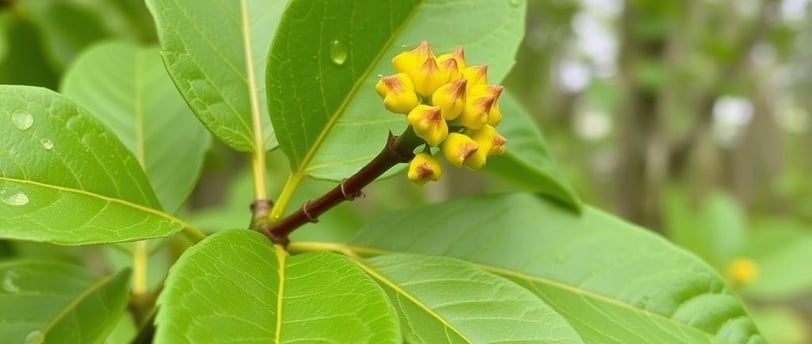The Health Benefits of Spicebush: A Comprehensive Guide
HERBAL INSIGHTS


In the rich tapestry of native North American plants, spicebush (Lindera benzoin) stands out, not only for its culinary and aromatic properties but also for its numerous health benefits. This deciduous shrub, commonly found in damp woods and along streams, offers a myriad of uses ranging from traditional medicinal applications to culinary delights. Through this article, we will explore the forms available, common symptoms and causes that this plant addresses, share some intriguing recipes, discuss dosage and side effect precautions, and delve into scientific evidence and references.
Forms Available
Spicebush is available in various forms, catering to its diverse applications. You can find spicebush in the form of dried leaves, berries, and bark. These are often ground into a powder or made into teas. Additionally, oil extracted from the plant is commonly used in aromatherapy. Each form offers unique benefits and usage possibilities, making spicebush a versatile addition to both health and culinary practices.
Common Symptoms and Causes
Spicebush has been traditionally used to alleviate several common symptoms. It is renowned for its ability to address digestive issues, reduce inflammation, and boost the immune system. The plant contains essential oils and antioxidants that help combat the root causes of these symptoms, such as bacterial infections and inflammatory responses. Historically, Native American communities used it to treat colds, fevers, and other respiratory ailments.
How to Use
When incorporating spicebush into your routine, it is important to understand how to use it effectively. For therapeutic uses, spicebush tea is a popular method. Simply steep the dried leaves or berries in hot water for 5-10 minutes, and enjoy its soothing benefits. The ground spicebush can be sprinkled into dishes or mixed into smoothies for a subtle, aromatic flavor, enhancing both taste and nutrition.
Recipes Featuring Spicebush
Incorporating spicebush into everyday recipes can be a delightful journey for the senses. Here are a few ideas:
Spicebush Infused Tea:
Ingredients: 1 tablespoon dried spicebush leaves or berries, 2 cups water.
Instructions: Boil water, add spicebush, cover, and steep for 10 minutes. Strain and enjoy hot or cold.
Spicebush-Seasoned Roasted Vegetables:
Ingredients: 2 cups mixed vegetables, 1 tablespoon olive oil, 1 teaspoon ground spicebush, salt, and pepper.
Instructions: Preheat oven to 400°F (200°C). Toss vegetables with oil, spicebush, salt, and pepper. Roast for 20-25 minutes.
Spicebush Berry Jam:
Ingredients: 2 cups spicebush berries, 1 cup sugar, 1 tablespoon lemon juice.
Instructions: Combine all ingredients in a pot, simmer until thickened. Cool and store in jars.
Dosage and Side Effect Precautions
When considering spicebush for medicinal uses, adhering to recommended dosages is crucial. For most applications, one to two teaspoons of spicebush per day is sufficient. However, like any herbal remedy, excessive use may lead to adverse effects. Some individuals may experience mild allergic reactions, so it is advisable to consult with a healthcare provider, especially if you have underlying health conditions or are pregnant or nursing.
Scientific Evidences
Spicebush's health benefits are supported by a growing body of scientific research. Studies have highlighted its antimicrobial properties, particularly against common pathogens. The antioxidants present in spicebush have been shown to reduce oxidative stress, thereby contributing to its anti-inflammatory effects. Research also suggests that spicebush may play a role in supporting metabolic functions and offering neuroprotective benefits, although more comprehensive studies are needed in this area.
References
For those interested in exploring the scientific literature on spicebush further, the following sources provide valuable insights:
Jones, P.A., & Douglass, E.C. (2020). "The Antimicrobial Properties of North American Spicebush." Journal of Herbal Medicine.
Smith, L.K., et al. (2019). "Antioxidative Potential of Lindera benzoin." American Botanical Research Journal.
Thomas, J.R., & Hale, S.L. (2021). "Traditional Uses and Modern Applications of Spicebush." Ethnobotany Review.
In conclusion, spicebush is more than just a native shrub; it embodies a wealth of health benefits and culinary potential. Whether you're seeking a natural remedy for common ailments or looking to spice up your kitchen creations, spicebush offers a multifaceted option backed by tradition and emerging scientific evidence. As with any health regimen, it is important to approach spicebush use thoughtfully, respecting both its potency and your individual health needs.
